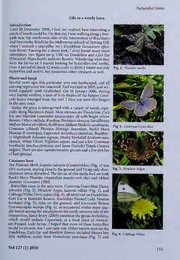
Life in a Weedy Lawn PDF
Preview Life in a Weedy Lawn
NaturalistNotes Lifeinaweedylawn Introduction Until 28 December 2009, I had not realised how interesting a patchofweedscouldbe.OnthatdayIwaswalkingalongafoot- path nearthe north-west side ofthe intersection ofBlackburn andNormanbyRoadsintheMelbournesuburbofNottingHill, when I noticed a caterpillar on a Dandelion Taraxacum offici- naleflower. Pausingfor a closerlook, I soon foundmanymore caterpillars (see figure on p. 150) on Dandelion and Cats Ear (Flatweed) Hypochoeris radicata flowers. Wonderingwhatthey were the larvae of, I started looking forbutterflies and moths. Overaperiodofabout 12weeksearlyin2010, 1foundnotonly Fig. 1. Plantainmoths butterfliesandmoths,butnumerousothercreaturesaswell. Plantsandfungi Several years ago, this particular area was landscaped, and all existingvegetationwasremoved.Turfwaslaidin2005,andwa- tered regularly until established. On 28 January 2006, during veryhumidweather, ahostoffruit-bodiesofthefungus Cono- cybe lactea emerged from the turf. I have not seen this fungus intheareasince. Today, the grass is interspersed with avariety ofweeds, espe- ciallyalong Blackburn Road. Mostobvious areDandelion, Cats Ear and Hawkbit Leontodon taraxocoides all with bright yellow , flowers.Othersinclude:PurslanePortulacaoleracea Smallflower , MallowMalvaparviflora RedflowerMallowModiolacaroliniana Common (ribbed) Plan,tain Plantago lanceolata Bucks Horn, , PlantainP. coronopus CapeweedArctothecacalendula Blackber- , , ryNightshadeSolanum nigrum MuskyStorksbillErodium mos- , chatum White Clover Trifolium repens andjustafewCommon , , SowthistleSonchusoleraceus,andSpear (Scotch)Thistle Cirsium vulgare.Therearealsovariousinvasivegrassesandafewpatches ofbareground. CreaturesSeen ThePlantainMothScopula rubraria (Geometridae) (Fig. 1) was verycommon,stayingcloseto thegroundandflyingonlyshort Fig.3. MeadowArgus distanceswhendisturbed. Thelarvaeofthis moth feedon both Bucks Horn Plantain (Australian insects web site) and ribbed plantain (Common 1990). Butterflies seeninthe areawere: Common Grass BlueZizina labradus (Fig. 2), Meadow Argus Junonia villida (Fig. 3), and CabbageWhitePierisrapae(Fig.4),allobservedonDandelion, Cats Ear or Hawkbit flowers; Australian Painted Lady Vanessa kershawi (Fig. 5), seen on the ground; and Common Brown Heteronympha merope (Fig. 6), an occasionalvisitormoreusu- allyfoundamongtheeucalyptsonthesouth-westernsideofthe intersection.SinceBraby(2005)mentionsthegenusArctotheca , which would include Capeweed, as a food plant of Austral- ian Painted Ladylarvae, I hoped that more ofthese butterflies wouldbepresent, butIsawonlyone. Otherinsectsseen onthe Dandelion, Cats Ear and Hawkbitflowers included Honeybee Fig.4. CabbageWhite Apis mellifera, native bees Homalictus punctatus (Fig. 7) and Vol 127 (I) 2010 155 NaturalistNotes Lasioglossum (Chilalictus) lanarium (Fig. 8), hover fly (Fig. 9), blowfly, a variety oftiny flies, and bugs from the superfamily Lygaedoidea (Fig. 10). During one of my visits, a sand wasp Bembixsp. cameto a patchofbareground, alightingonlyvery briefly. It was a beautiful insect, about the size ofa European wasp,withyelloweyes andablueandblackstripedabdomen. OnliftinguptheleavesofsomeoftheweedsIglimpsedhosts ofother arthropods scurrying away to safety: tiny red mites; elusive, well-camouflaged spiders; bugs and beetles (includ- Fig.5. AustralianPaintedLady ing weevils) ofvarious shapes, sizes and colours; and numer- ous smallbrown ants. Early in the morning, manyofthe bugs andbeetlescouldbeseenonthefootpath (seefigureonp. 114). Theyeitherproceededacrosstothenaturestripwheretherewas similarhabitat,orreturnedwhencetheycame.Byabout9.30am EDTmostofthemwerewellhiddeninthevegetation,andgen- erallyremainedso duringdaylighthours. Theants,bycontrast, couldbeseenallday. InMarch,afewwingedgrasshopperswere present. I hadn’t noticed them before, so I don’t know ifthey Fig.6. CommonBrown werethereallalongoriftheyarrivedaftertheywereabletofly. I never found outwhat those caterpillars would have turned into.AccordingtostaffatMuseumVictoria(pers.comm.),they wereprobablylarvaeofmothsinthefamilyNoctuidae,afamily with almost 2000 species (Zborowski and Storey 2003). They musthavebeen unpalatable tobirds, because although easyto see, they were not eaten by the Australian Magpies Cracticus tibicen Common Starlings Sturnus vulgaris or Common My- , nasS. tristis thatforageinthe generalarea. An evenworsefate awaited them, for on 6 January 2010 their brief lives ended whentheyweremincedupbyalawnmower. Fig.7. Nativebee VirgilHubregtse 6Sanikystreet NottingHill,Victoria3168 Acknowledgements ThankyoutotheDiscoveryCentrestaffatMuseumVictoria,especially SimonHinkley,forinformationaboutseveraloftheinsectsseen. References AustralianInsectswebsite<http://australian-insects.com/lepidoptera/ster/rubrar. html>(viewed24April2010) M Braby (2005) The completefield guide to butterflies ofAustralia (CSIRO: Collingwood,Vic.) Common, IFB (1990) Moths of Australia (Melbourne University Press: Fig.8. Nativebee Melbourne) ZborowskiPandStoreyR(2003)AfieldguidetoinsectsinAustralia.2nded.(Reed NewHolland:Sydney) Fig. 10.Bugsfrom thesuperfamily Lygaedoidea Fig.9.Hoverfly 156 TheVictorianNaturalist
